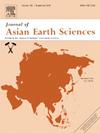IF 2.7
3区 地球科学
Q2 GEOSCIENCES, MULTIDISCIPLINARY
引用次数: 0
摘要
祁连山的隆升历史和现代地貌的形成时间是建立青藏高原北扩模式的关键因素,尽管之前的研究已经取得了全面的成果,并对祁连山两端的地区有了一定的了解。位于祁连山北段中东段的盖章达坂山区,花岗岩和寒武纪变质地层相互交织,共同造就了祁连山-河西走廊中部明显的地貌特征。我们采用磷灰石(U-Th)/He 和锆石(U-Th)/He 热年代学方法,发现了从 300 Ma 到 75 Ma 的一系列主要年代。根据我们的热时学数据得出的冷却路径模型阐明了两个不同的冷却事件,其年代分别为 ∼78 Ma 和 ∼15 Ma。通过对祁连山山脉热历史的比较分析,我们提出了一个从南至北的渐进隆升过程,该过程始于晚白垩世,几乎同时发生在中新世。我们假设,晚白垩世的冷却事件主要受到拉萨和羌塘地块碰撞的远场效应的影响。随后发生的中新世快速隆升事件则归因于新特提斯洋的关闭以及青藏高原随之向外扩张。本文章由计算机程序翻译,如有差异,请以英文原文为准。
Tectonic uplift since the late Mesozoic and early geomorphological development of the north Qilian Shan on the NE Tibet Plateau: Insights from low–temperature thermochronology
The uplift history of the Qilian Shan and the formation time of modern landforms are key factors in establishing a northward expansion model of the Tibetan Plateau, although previous studies have obtained comprehensive results and an understanding of the areas at both ends of the Qilian Shan. The Gaizhangdaban Shan area, located in the mid–eastern section of the northern Qilian Shan, is characterized by the interplay of granite and Cambrian metamorphic strata, which collectively contribute to the pronounced topographical features in the central part of the Qilian Shan–Hexi Corridor. We employed apatite (U–Th)/He and zircon (U–Th)/He thermochronology, revealing a range of dates predominantly spanning from 300 Ma to 75 Ma. The cooling path model derived from our thermochronological data elucidates two distinct cooling events, dated at ∼78 Ma and ∼15 Ma respectively. Through a comparative analysis of the thermal history across the Qilian Shan range, we proposed that a progressive uplift extending from southern to northern regions commenced in the Late Cretaceous and occurred almost concurrently during the Miocene. We hypothesized that the Late Cretaceous cooling event was influenced primarily by the far–field effects of the collision between the Lhasa and Qiangtang blocks. The subsequent rapid Miocene uplift event is attributed to the closure of the Neo–Tethys Ocean and the consequent outward expansion of the Tibetan Plateau.
求助全文
通过发布文献求助,成功后即可免费获取论文全文。
去求助
来源期刊

Journal of Asian Earth Sciences
地学-地球科学综合
CiteScore
5.90
自引率
10.00%
发文量
324
审稿时长
71 days
期刊介绍:
Journal of Asian Earth Sciences has an open access mirror journal Journal of Asian Earth Sciences: X, sharing the same aims and scope, editorial team, submission system and rigorous peer review.
The Journal of Asian Earth Sciences is an international interdisciplinary journal devoted to all aspects of research related to the solid Earth Sciences of Asia. The Journal publishes high quality, peer-reviewed scientific papers on the regional geology, tectonics, geochemistry and geophysics of Asia. It will be devoted primarily to research papers but short communications relating to new developments of broad interest, reviews and book reviews will also be included. Papers must have international appeal and should present work of more than local significance.
The scope includes deep processes of the Asian continent and its adjacent oceans; seismology and earthquakes; orogeny, magmatism, metamorphism and volcanism; growth, deformation and destruction of the Asian crust; crust-mantle interaction; evolution of life (early life, biostratigraphy, biogeography and mass-extinction); fluids, fluxes and reservoirs of mineral and energy resources; surface processes (weathering, erosion, transport and deposition of sediments) and resulting geomorphology; and the response of the Earth to global climate change as viewed within the Asian continent and surrounding oceans.
 求助内容:
求助内容: 应助结果提醒方式:
应助结果提醒方式:


